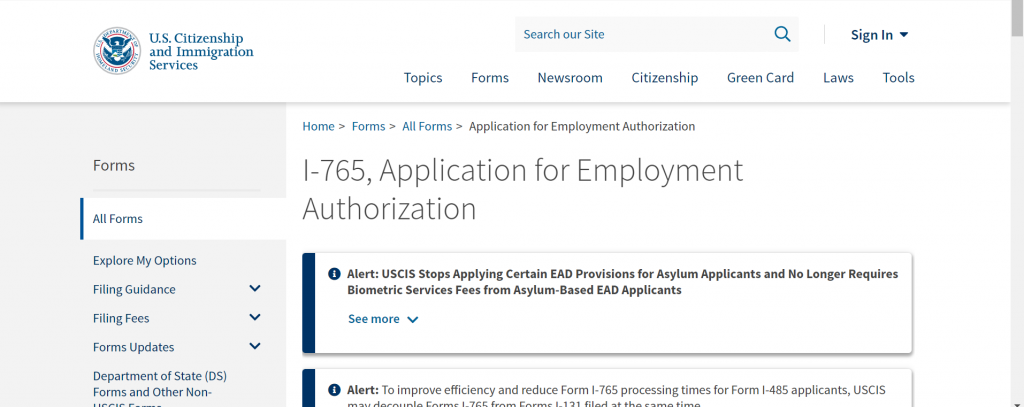Editorial Integrity
Moving to the US can feel overwhelming, filled with unknowns and uncertainties. HomeAbroad editorial team includes certified immigration experts/USCIS nerds who translate complex legalese into clear, actionable moving and visa guides. Rest assured, every article undergoes a reader-centric editorial process to ensure accuracy and reflect current regulations.
Are you a foreign national living in the USA and willing to join the most dynamic and progressive workforce in the world? Then having an in-depth understanding of EAD is of imminent importance now than it has ever been before.
While the idea of working in the USA is quite exciting, it can turn sore if you don’t have the necessary documents in place. So, in order to have a smooth transition from living to working in this land of opportunities, it is advisable to have all your documentation done and filed before you step out and start working for an organization here. And, EAD is like a key that you would need to realize all your dreams.
Let’s walk through the nuances of this critical piece of document and every other detail and query related to it along the way. Let’s start with the basics, shall we?
Table of Contents
What is an EAD?
An EAD, or Employment Authorization Document, is issued by the United States Citizenship and Immigration Services (USCIS), giving a foreign national the right to work in the United States.
It is a nonimmigrant visa work permit. It is a plastic card with the individual’s photo, name, and the dates for which the EAD is valid. The EAD allows the holder to work in any job, with any employer, for the duration specified on the EAD card.
If you are a nonimmigrant and looking forward to working in the United States of America, consider EAD as your magic key to unlocking the plethora of opportunities lurking around you. To gain further clarity as to why you need EAD, continue reading.
Why do you need an EAD?
If you want to work in the United States, you will need an EAD. Even if your visa status allows you to work in the United States, you will still need an EAD to work legally.
For example, H1B visa holders are allowed to work in the United States, but they will need an EAD to work legally. Similarly, F-1 students who have completed their studies and are on Optional Practical Training (OPT) are allowed to work, but they will need an EAD.
Now that you know what EAD is and why you need it let’s move to the next step and understand the procedure of applying for one.
How to apply for EAD?
Here is a step-by-step guide to help you with the process of obtaining EAD.
Step 1: File Form I-765
the first step for getting an EAD card is to fill out Form I-765, which is available on the USCIS website. You can download the form and start filling it out. It is important to download the form because the United States Citizenship and immigration services (USCIS) make changes to the form quite frequently.
Form I-765 has a designated space for personal information and a separate section for questions, depending on which you will be required to submit certain documents.

Step 2: Attach supporting documents
The supporting documents that you need to submit with your EAD application will depend on your specific situation. For example, if you are applying for EAD based on your status as an H-1B visa holder, you will need to submit a copy of your H-1B approval notice. Similarly, if you are applying for EAD as a student on OPT, you will need to submit a copy of your Form I-20. However, if you are moving to the USA for the first time due to your work requirements, you must ensure you grab everything mentioned on the checklist before applying for EAD.
You will need the following supporting documents to file Form I-765:
- A copy of your I-94 travel record.
- A printout of your electronic I-94 obtained from U.S. Customs and Border Protection (CBP)
- Copy of your U.S. visa
- Copy of your passport photo
- Copies of previous work permits, if any
- Two 2-inch-by-2-inch passport-style photos.
- print your full name and Alien Registration Number on the back of each photo with a pencil or felt-tip pen
- Copy of receipt notice from USCIS that your green card application (Form I-485) is pending; this is applicable only if:
- Your sponsor has a green card.
- Your sponsor is a U.S. citizen.
- You are applying for a work permit after submitting your green card application.
If you have not been issued a work permit before, you must also submit a copy of one of them,
- Birth certificate
- A photo ID
- Copy of a visa issued by the consulate of any other country than the United States of America.
- Other national identity documents with your photo and/or fingerprint
Step 3: Attach the fee receipts
Don’t forget to attach the fee receipt to Form I-765 before submission. In case of default, USCIS will defer your application, not process filing, and neither will your biometrics be considered.
Step 4: Submit the application
- After going through the entire process of downloading the form, filling in the details, attach the supporting documents and receipts, you are now ready to take the final step, submission. Again, you may either make the submission via mail or online through e-filing.
- Mail: If you are sending in your application through mail, do cross-check the address at least twice because different categories and states have different USCIS locations. So make sure you send yours to the right address.
- E-filling: You may avail the option of filling and submitting the form online. However, it would require you to scan and mail all the supporting documents along with the form.
EAD card processing time
It usually takes around 90 days. Submission of application is usually preceded by a notice indicating whether or not your application is approved.
If USCIS approves your application, you will receive your EAD card in about 90 days; else, you will be mailed the reasons for not being mailed one.
How much does the EAD cost?
The cost of an application can be categorized into two parts
- Filing fee – $410
- Biometrics fee – $85
The biometric fee is applicable to those individuals who fall into any of the following segments; the rest need not pay the biometric fee.
- If you are requesting Deferred Action for Childhood Arrivals (DACA)
- Spouses or unmarried dependent children of beneficiaries have the approval for an employment-based immigrant petition.
You may choose to make the payment through a debit/credit card or even send a money order. Please note that USCIS does not accept cash.
Who is exempted from the Filing fee?
If you fall under any of these categories, you may request an exemption from the filing fee.
- Citizens of Micronesia, Palau, or the Marshall Islands
- Those Granted Withholding of Deportation
- Asylees, Refugees, or those Paroled as Refugees
- N-8 or N-9 nonimmigrants
- Victims of Severe Forms of Trafficking
- VAWA Self-petitioners
- U-1 Nonimmigrants
- Dependent on an international organization, foreign government, and NATO personnel
- Applicants for Asylum
USCIS considers fee waivers for the following categories; if you fit into any one of these, you may request a fee waiver. However, you will be required to attach the required documents along with the waiver request.
- If you are currently a beneficiary of the means-tested benefit. Means-tested social benefits are indicative of the benefit entitlement explicitly or implicitly depending on the beneficiary’s income/wealth.
- This covers cases where income/wealth is used to determine (1) only entitlement or (2) both entitlement and amount.
- If your annual household income is below 150% of the Federal Poverty Guidelines at the time of your filing.
- If you are currently undergoing financial hardships and are unable to pay the fees. Unexpected medical bills or emergencies fall into the category of financial hardships.
- If you are availing the benefits of any of these mean-benefit programs, such as Medicaid,
Temporary Assistance to Needy Families (TANF), Supplemental Nutrition Assistance Program (SNAP or food stamps), or Supplemental Security Income (SSI), you may request a fee waiver.
How to track your EAD card?
Once your card is out for delivery, you can track its status by signing up for Informed Delivery
through USPS. You will get daily images of mail being sent to you; also, you can,
- Set up email and text alerts
- Add delivery instructions for the mail carrier
In case the tracking system shows that the mail has been delivered, but you haven’t received any yet, you must contact the local post office urgently.
If you have shifted your residence, do update the same with USCIS and USPS immediately.
USPS recommends that applicants use USPS Look Up a ZIP Code tool in order to ensure that they give USCIS their full address using the standard abbreviations and formatting recognized by USPS.
If you fail to update your address, your card may be delayed, you may risk losing your documents, and you may end up reapplying and paying the fee again.
How long is the EAD valid?
After you get your EAD card, you may start working at the earliest opportunity. The card is usually valid for 1 year. When the EAD is close to expiring, you must file a renewal within 180 days of its expiry. Whether you are required to apply for EAD renewal once or several times depends on the type of visa you hold at the given point in time.
How to renew an EAD?
We already know that EAD cards have restricted validity, so you will have to renew your EAD card again. EAD card’s validity usually lasts for a year, and this is primarily to keep with the validity of the visa that the applicant may possess.
The process of renewal is quite simple and may feel familiar too; however, consider the following pointers, and the renewal would seem like a cakewalk,
- You must cross-check the eligibility criteria before applying for the renewed EAD.
- The window for renewal opens only when there are 180days left for the expiry of your current EAD card.
- You must apply for renewal when your current EAD card is179 days away from the date of expiry.
- Fill the Form I-765 and pay the filling and biometric fee as before, and make the submission on time.
- Any delay would have a cascading effect, and you may find yourself in an uncomfortable situation.
- Therefore, you need to be extensively prompt while applying for the renewal of EAD.
Differences between an EAD card and a green Card
It is not unusual for people to get confused between an EAD Card and a Green card. In this section, we will address the difference between the two to help you better understand the USCIS system.
An EAD approves and permits that a foreign national is eligible for employment in the U.S. It primarily allows the holder to work in the USA; however, it does not grant permission for entering the USA, as it depends on the status of your Visa. Thus, you need a Visa to get an EAD.
A Green Card is a step ahead of Visa, as it grants the holder the right to permanent residency in the USA. Though the Green card too requires renewal at regular intervals, it can be used in lieu of a passport if you are traveling abroad and re-entering the USA. And, to top the benefits of a Green card, it can also be considered as your permit to work in America.
EAD work restriction vs. H1B work restrictions
Understanding the work restrictions between EAD and H1B visas is critical as it will help you gain an insight into how EAD is better than HIB Visa in terms of restrictions.
- Eligibility: EAD can be availed by non-resident immigrants staying in America. But in the case of H1B, you must either have education or experience along with a copy of the job offer from a US-based company.
- Employment Restrictions: Foreign national who is in the United States on an EAD can work for any employer, provided that the employment is in an occupation that corresponds to the EAD category. In addition, there are no restrictions on the number of hours that can be worked. On the other hand, H1B visa holders can only work for their sponsoring employer.
- Work Hours: EAD holders can also work for any number of hours, while H1B visa holders are restricted to working no more than 40 hours per week.
- Validity: EAD depends on the duration and status of the Visa, whereas H1B is valid for 3 years and is extendable for up to 6 years.
- Quota: There is no limit on the number of EADs issued by the USCIS (U.S. Citizenship and Immigration Services)on a yearly basis. However, only 65,000 visas are issued per year, with an additional 20,000 being blocked for people pursuing Master’s or higher education.
- Time: While you may apply for an EAD round the year, you have to be extremely lucky to find your place in a HIB lottery conducted on April 1st every year.
How to rectify an error in the EAD card?
If an error has occurred in your EAD card, you may request for corrected card by refilling Form I-765 and submitting the errored card, along with all the documents as before.
However, if the mistake has occurred from the USCIS’s side, all you need to do is submit a cover letter explaining the mistake, along with the documentation that may help USCIS rectify the mistaken information. For example, if your name or date of birth is printed wrongly, you may provide a copy of your driver’s license or passport in order to stand true to your claim and submit these in the service center or at the National Benefits Center, which had approved your previous Form I-765. In such cases, you are not required to fill out a fresh form or repay the fee.
What to do in case of lost/ stolen, or damaged EAD?
If you lose your EAD, you should contact U.S. Citizenship and Immigration Services immediately and follow the prescribed procedure for procuring a replacement or new EAD.
You will need to complete a new application, Form I-765, and submit it along with the required fee, and most importantly, mention that you are requesting for a replacement. Once your EAD is approved, you will be able to pick it up at your local USCIS office or have it mailed to you. Of course, if you have any questions, you can always contact USCIS for assistance.
Conclusion
An Employment Authorization document is like your driving license. Though you may know how to drive, unless you have a license, you cannot drive legally. In the same way, EAD is your license to work legally in the United States of America. Having a work permit allows you to focus on your work without any inhibitions and undue worries. So, now is your chance to apply for your Employment Authorization document by filling the Form I-765 and kick-starting your journey of growth and progress.
Frequently asked Questions
1. How do I know if I am eligible for EAD?
To be eligible for EAD, you must have a valid immigration status that allows you to work in the United States. For example, H1B visa holders are allowed to work in the United States, but in order to work legally, they will need an EAD. The same goes for the F-1 students who have completed their studies and are pursuing Optional Practical Training. They, too, require an EAD to begin the work.
2. How long does it take to get EAD?
The processing time for EAD applications can vary depending on the USCIS workload, but it usually takes around 90 days.
3. How much does it cost to apply for an EAD?
The filing fee for EAD is $410 as of 2022. You will also need to pay a biometrics fee of $85 if you are between the ages of 14 and 78.
4. Where can I get Form I-765?
You can get Form I-765 from the USCIS website, U.S. consulate, or embassy abroad, or you may also collect it from the nearest USCIS office. If you are already residing in the United States, you can acquire one from your current employer or from the school you are currently attending.
5. Can I work while my EAD application is pending?
If you have a valid EAD, you can work while your EAD application is pending. However, if your EAD has expired, you will need to stop working until your EAD application is approved.
6. Do I need to renew my EAD?
To renew an EAD, you must fill and submit form I-765. Since the EAD processing time is around 90 days from the date of the submission, it is advisable to fill out the application and submit it 180 days before the date of expiration of the current EAD card. However, filling out Form I-765 should be done cautiously to avoid accidentally entering the wrong details/ information, which may result in the denial of the application.
Make sure your application has all the required EAD Renewal documentation, which will help prove your identity along with your eligibility for this specific immigration benefit. You may also be required to submit copies of the original documents used earlier when you must have applied for your previous EAD, depending on your immigration status.
7. Can I travel while my EAD application is pending?
If you have a valid EAD, you can travel while your EAD application is pending. However, if your EAD has expired, you will need to stop traveling until your EAD application is approved.
8. Can I apply for EAD from outside the United States?
Yes, you can apply for EAD from outside the United States. However, you will need to submit your EAD application to a U.S. consulate or embassy. You can find more information about EAD applications from outside the United States on the USCIS website.
9. I am having trouble with my EAD application. Who can I contact for help?
If you are having trouble with your EAD application, you can contact the USCIS National Customer Service Center for assistance. You can also visit your nearest USCIS office or U.S. consulate, or embassy for help. Finally, you can also contact an experienced immigration attorney for assistance.

















